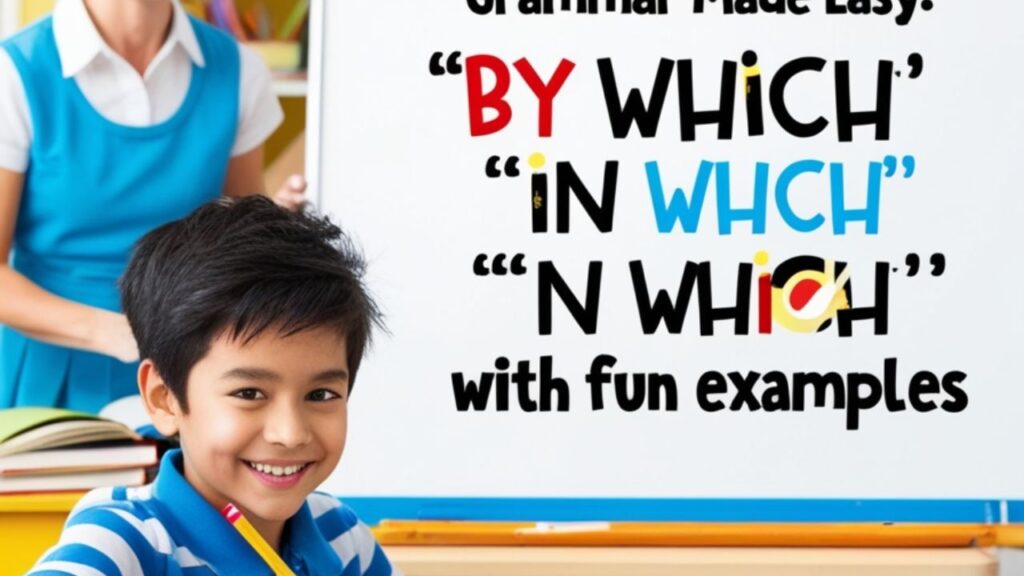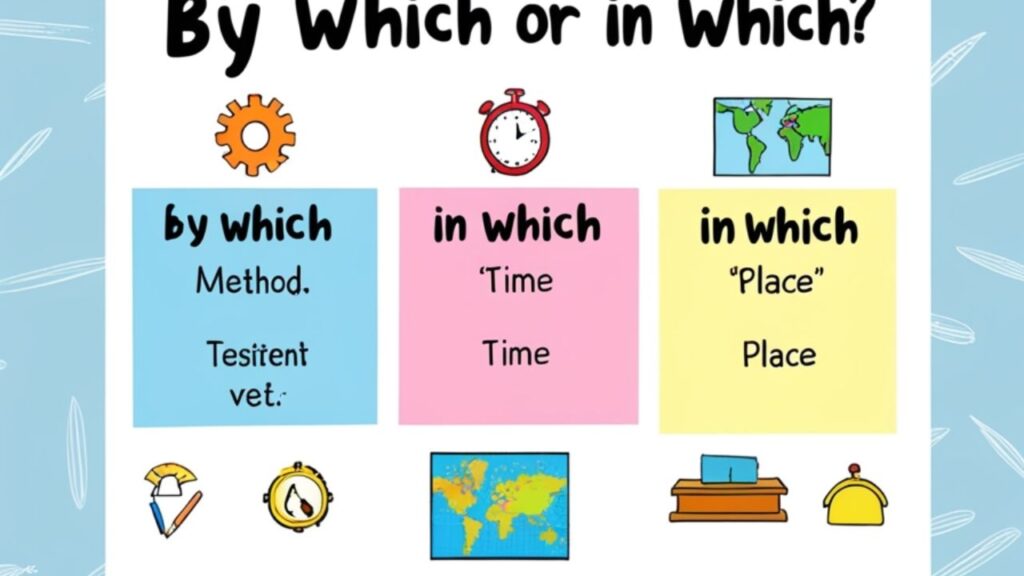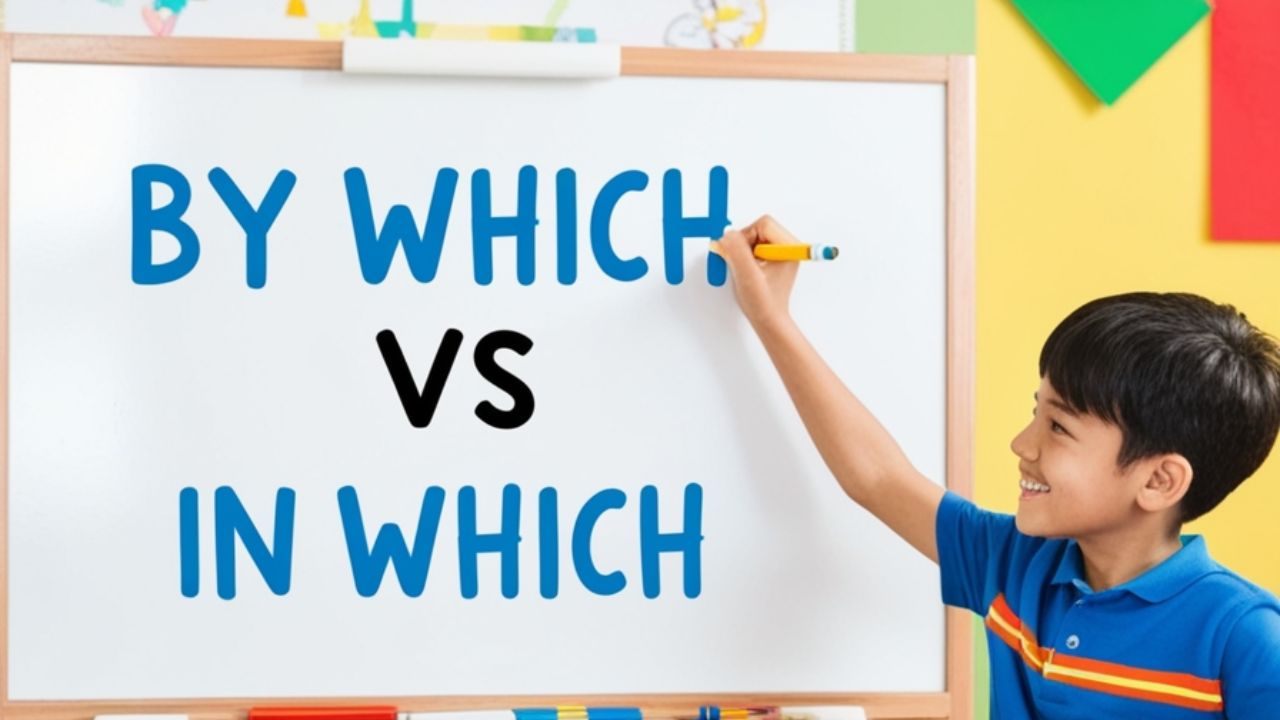The phrases by which and in which help writers make clear sentences. One shows a way or method, and the other shows a time or place. Knowing their use helps children write simple and correct lines in school work.
Teachers often explain that by which talks about how something happens. It is used in lessons, reports, or stories that describe action or process. This phrase gives meaning to ideas and makes writing sound proper and complete for readers.
The phrase in which tells about where or when something takes place. It fits well in stories, essays, or lessons that show moments or situations. Using it helps students build neat sentences and learn grammar with confidence and care.
Understanding the Key Difference Between “By Which” and “In Which”
| Phrase | Function | Common Use Case | Tone | Example |
| By which | Indicates method, means, or cause | Refers to how something happens or is done | Formal | “The method by which we resolved the issue…” |
| In which | Refers to context, situation, or place | Describes where or when something takes place | Formal | “The meeting in which the decision was made…” |
Here’s the golden rule:
- Use by which when you talk about how something happens or works.
- Use in which when you describe where or when something takes place.
- Replace by which with “how” to test correctness.
- Replace in which with “where” or “when” for a quick check.
- Always match the phrase to its meaning — method or setting.
How to Use “In Which” Properly
The phrase “in which” is a preposition-pronoun combo used to add clarity and precision when referring to non-physical places, situations, or points in time.
Common contexts:
- By which appears in formal lessons, reports, and explanations showing how something is done.
- In which fits sentences that tell about time, place, or event.
- Used often in academic writing to explain ideas clearly.
- Found in legal documents describing processes or cases.
- Used in stories or essays to describe moments or settings neatly.
Examples:
- The road by which we reached the park was long and quiet.
- The story in which the hero learns kindness is touching.
- The rule by which the game is played is simple.
- The meeting in which we shared ideas went well.
- The plan by which success was reached worked perfectly.
Tip:
Always use in which when you talk about time, place, or situation. Use by which when you show how something happens. These short phrases make your writing sound clear. They help you share ideas simply and keep your sentences correct.
Remember that in which fits for stories, lessons, or reports. By which fits for actions, plans, or methods. When you choose the right phrase, your grammar becomes strong. Keep practicing with easy examples to learn them better every day.
When to Use “By Which” (And What It Really Means)

Writers use by which to show the way something happens or works. It tells the method or process that helps complete an action. This phrase is useful in stories, lessons, and reports where clear steps or causes are explained.
Teachers use by which to help students learn how things are done. It makes sentences neat and meaningful. For example, “The road by which we reached school was short.” Using it correctly builds strong writing habits and clear understanding of grammar.
Common contexts:
- By which helps explain how something happens in reports or research work.
- In which fits when describing a place, time, or event in stories or lessons.
- Used often in legal writing to show steps or actions clearly.
- Seen in technical notes when explaining methods or processes.
- Common in academic essays that discuss ideas, moments, or results.
Examples:
- The rule by which the school runs keeps everyone safe and fair.
- The story in which the hero learns bravery is exciting to read.
- The method by which plants grow needs sunlight and water.
- The game in which we played together was full of joy.
- The process by which books are made starts with good ideas.
Avoiding Common Mistakes: By Which vs In Which
Even native speakers mix them up – especially in formal writing. Here are the most frequent errors and how to fix them.
Mistake 1: Swapping them interchangeably
Many learners mix by which and in which in sentences. Each phrase has its own job. One shows how something happens, and the other tells where or when it happens. Using the wrong one changes the meaning and makes writing unclear.
To write correctly, remember the difference between by which and in which. Read examples and practice short sentences daily. Careful use helps your grammar sound right. Small steps in learning bring strong results in every story, lesson, or paragraph you write.
Mistake 2: Overusing them in casual writing
Writers sometimes use by which or in which too often in simple talk. These phrases sound formal and suit school lessons or reports. In daily speech, short and clear words make ideas easier for friends and teachers to understand.
Good writing keeps balance between formal and simple phrases. Use by which and in which only when they fit the sentence. Simple language helps your thoughts shine. Clear writing shows confidence and helps readers enjoy every line you share.
Mistake 3: Using “where” in place of “in which” improperly
Some learners use where when they should write in which. The word where fits real places, like parks or schools. The phrase in which works for ideas, times, or events that don’t describe a physical space.
Writers need to remember that in which sounds correct in formal writing. It keeps sentences neat and proper. For example, “The moment in which she laughed” is right. Careful practice helps children build strong grammar and clear expression every day.
See also Polite vs Courteous: The Subtle Difference Explained
Sentence Surgery: Real Examples Fixed and Explained
Let’s look at flawed examples pulled from real-world forums, and clean them up:
Incorrect:
“The way where we arrived at the solution was unorthodox.”
Correct:
“The way by which we arrived at the solution was unorthodox.”
Incorrect:
“The story by which he told shocked everyone.”
Correct:
“The story in which he told the truth shocked everyone.”
Formality, Clarity, and Context: Why Precision Matters
Using these phrases correctly doesn’t just improve grammar – it elevates your writing.
Where it really matters:
- In academic papers, correct grammar shows clear and smart thinking.
- In legal writing, small errors can change the meaning of a rule.
- In official reports, precise words make ideas easy to understand.
- In technical guides, clear phrases explain each step correctly.
- In school essays, neat grammar builds strong writing habits early.
By Which or In Which: Quick Decision Guide
| Ask Yourself… | Use This Phrase | Why? |
| Are you describing how something was done? | By which | You’re focusing on the method or means |
| Are you describing where or when it occurred? | In which | You’re identifying a context or situation |
| Are you referencing a legal, technical, or formal situation? | Depends on logic | Choose based on whether you’re referring to a process or a context |
| Would “where” sound awkward or imprecise here? | In which | Formal tone benefits from clarity |
Mini Quiz: Can You Spot the Right Phrase?
A short quiz helps learners understand the use of by which and in which. Reading small examples and choosing the right one builds confidence. It trains the mind to notice meaning and structure in every sentence easily.
Practice sentences like puzzles make learning fun. When children see how by which shows a method and in which shows a place or time, they learn faster. Regular practice with examples improves grammar and makes writing sound smooth and correct.
Case Study: Legal vs Technical Writing

Legal Writing Example
In legal writing, by which helps show how a law or rule works. It explains the method or process clearly. For example, “The rule by which the office was formed” tells how something was made or started in a proper way.
Writers use by which to keep legal sentences neat and correct. It gives strong meaning to actions and laws. Clear grammar in such writing avoids confusion and builds trust. Practicing this style helps learners understand how official language stays precise.
Technical Writing Example
In technical writing, in which helps show the place or situation of an action. It tells where something happens in a report or experiment. For example, “The test in which the data was checked” explains the setting of the work.
Writers use in which to make reports clear and exact. It helps describe steps, times, or spaces in easy form. This phrase keeps the language formal and tidy. Learning its right use helps students write strong and careful technical notes.
See also Backyard or Back Yard: Which Spelling Is Right?
Writing Tip:
When in doubt, reword the sentence using “how” or “where.” If “how” fits, use by which. If “where” or “when” fits (formally), use in which.
Expert Insights: What Editors and Linguists Say
Language experts explain that by which and in which show careful thinking. These phrases help writers express ideas correctly. Editors believe that using them the right way makes writing neat, clear, and respectful to both the reader and the subject.
Linguists teach that small grammar choices show big understanding. When learners use by which or in which properly, their sentences sound polished. Teachers often say that correct use of such phrases builds strong habits for future studies and professional writing.
By Which or In Which? Cheat Sheet Summary
| Context | Correct Phrase | Sample Sentence |
| Method or process | By which | “The route by which the message is delivered is encrypted.” |
| Situation, setting, time | In which | “The year in which they graduated was historic.” |
| Abstract case or scenario | In which | “The case in which the verdict was overturned…” |
| Means of creation or function | By which | “The algorithm by which it operates…” |
Final Thoughts
Learning to use by which and in which makes writing clear and correct. These phrases help students build strong grammar. With simple practice and examples, every child can understand how to use them in school work and stories easily.
Good grammar shows careful thinking and respect for language. When learners write clearly, their ideas shine. Using by which and in which in the right places helps them grow confident. Step by step, strong writing becomes a joyful and proud skill.
FAQs
What is the difference between by which and in which?
“By which” shows method or means; “in which” refers to location, situation, or context.
When should I use which or in which?
Use “which” for objects; “in which” adds context like place, time, or condition.
How do you use by which in a sentence?
Example: “He found a method by which he could succeed,” meaning “using which.”
What do you mean by “which”?
“Which” introduces a clause or question to specify one or more items from a group.

Join Bibcia on a journey to master English grammar. Discover easy lessons, writing tips, and practical examples designed to make learning grammar simple and effective.










